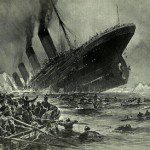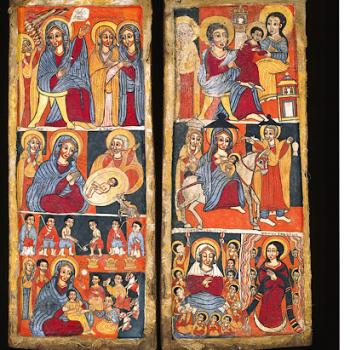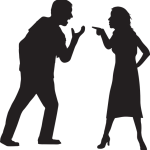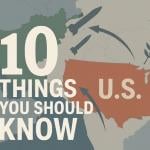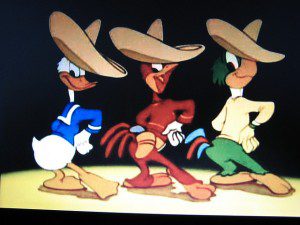 Three Caballeros is an experimental movie, a licit drug trip disguised as an animated movie. Walt did not control his studio in World War II, the government did, but Walt refused to surrender creativity. This is another “package” movie… a series of cartoons thinly linked together as birthday presents to Donald Duck. If you think your great-grandfather lived in creatively sterile times, watch this film and compare the risks Walt took with the Ninties Disney revival.
Three Caballeros is an experimental movie, a licit drug trip disguised as an animated movie. Walt did not control his studio in World War II, the government did, but Walt refused to surrender creativity. This is another “package” movie… a series of cartoons thinly linked together as birthday presents to Donald Duck. If you think your great-grandfather lived in creatively sterile times, watch this film and compare the risks Walt took with the Ninties Disney revival.
I love Aladdin, but it is a 1950’s musical disguised as a cartoon. No wonder Disney has taken such movies to Broadway since that is their true birthplace. The effects in the inferior film Three Caballaros could not be done on stage… Walt and his team were stretching the medium, not copying another. There could not have been Cinderella or the second Golden Age under Eisner (so much more careful!) if Walt and his creative team had not been willing to take risks. They kept learning even when learning seemed futile on simple little projects.
What does Walt teach us in this movie?
Walt is unafraid in this film of mixing normal human desires into his movies and allowed his wholesome crew passions. The three caballeros liked . . . girls. At the time, this made puritanical types grouchy and now the new puritans are upset because one of the three smokes a cigar. . . the horrors of the 1940s! Admittedly, the three caballeros are birds and so their dating lives would be odd if we thought about it . . . but they also wear clothes, sing, dance, eat human food, and are interested in human customs. They are people in a different form and nothing like a duck, rooster, or parrot.
Decent people, and Walt at least tried to represent decent people, are unpopular today. Prudes are worried they are having fun that might be bad for their health (physical well being is everything to the new prudes!) while libertines dislike the notion of decency. The three caballeros are having jolly, normal fun. The images of Carnival in Rio reinforce the point: I saw young men in ties! Apparently, it was still possible to party in the 1940s with decency and moderation. I am confident (having talked to my grandparents!) that bad stuff happened on the back streets, but if you wished to be decent this was allowed.
If barbarism is allowed in public, the decent will be driven away altogether. The libertines can always go from the “main party” to the backrooms, but when the backroom becomes the main party, there is no decent fun left at the party. Excess will consume prudence and the cultural hangover will be great. Walt and his three caballeros are having a rollicking time. They are not limited by irrational prejudice or prudery, but they are also bound by certain limits. They will go “thus far” while honoring societies moral code.
But that does not lead to “same old” or conformity: instead it leads to what one person called “an acid trip” set of cartoon effects. I would note that if this is so, if an acid trip does give one these effects, then Disney gave these visions to the rest of us without any of the dangers of drugs. Walt and his merry band were unconstrained by “what had been done before now” in the art form. Moral codes did not really limit them by closing off barbarism, but pushed them forward to experiment with the billions of licit artistic combinations that exist in God’s universe. Some of it was silly, some of it failed, but all of it was jolly.
This jollification was the goal of the cartoon: international relationships could be warm and friendly. The writers of Three Caballeros called it “gay” back then . . . three gay caballeros . . . but that was another and different time. .




